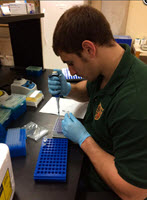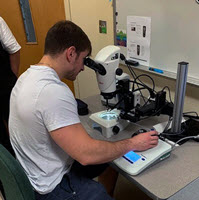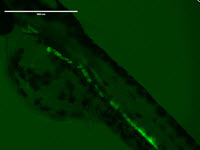
Following Deepwater Horizon, there was concern about how the oil spill might affect marine life. Since then, scientists have learned more about how polycyclic aromatic hydrocarbons (PAHs) affect marine organisms, especially commercially and recreationally important fisheries. For example, they found that that exposure to PAHs during a fish’s early life stages (embryo and larvae) can induce sublethal impacts, such as reduced cardiac function, that affect the organism’s overall fitness and health.
Fabrizio Bonatesta is contributing to this research by conducting genetic analyses on oil-exposed zebrafish embryos to assess effects on kidney development and function. “Although a freshwater fish, the zebrafish represents an excellent model for this study because the normal development of the zebrafish kidney is well-characterized,” Fabrizio explained. “We plan to follow-up with similar studies on ecologically and economically relevant species native to the Gulf of Mexico coast, such as red drum.”
Fabrizio is a Ph.D. student with the University of North Texas’s Department of Biological Sciences and a GoMRI Scholar with Relationship of Effects of Cardiac Outcomes in Fish for Validation of Ecological Risk II (RECOVER II).
His Path

Fabrizio grew up in Brindisi, Italy, a small port town where he often spent his free time scuba diving, snorkeling, and enjoying the natural beauty of the beach. Due to its strategic location on the Italian Peninsula and Adriatic Sea, Brindisi is now a popular location for industrial businesses, including chemical and petroleum industries. Despite the economic swell, the influx of these businesses has affected the area’s coastal environment and its residents. “Over the years, I’ve witnessed multiple beached marine mammals and marine fauna degradation possibly related to anthropogenic impacts on the Adriatic Sea ecosystem,” Fabrizio said. “These damages to the marine habitat I hold so close to my heart motivated me to improve my understanding of the circumstances harming the Brindisi coast.”
Fabrizio completed dual undergraduate degrees in biology and marine science at the University of Miami, where he developed a strong foundation in aquatic toxicology and a broad understanding of marine ecosystems. As he anticipated graduate studies, Fabrizio toured the university’s Rosenstiel School of Marine and Atmospheric Science and chatted briefly with Dr. Edward Mager, who was an assistant researcher at the time. Later, when Fabrizio applied to graduate school, he learned that Dr. Mager was now at the University of North Texas and assembling his lab team. Fabrizio reached out and was surprised that Dr. Mager remembered their brief conversation, which led to Fabrizio joining Dr. Mager’s team as his first graduate student and pursuing an environmental science degree with a toxicology focus. “I feel that achieving this degree will allow me to maximize the contributions I can make to preserve the aquatic environment,” said Fabrizio. “If I can better understand the impact that toxicants are having on the environment, I will be able to help develop solutions to improve the quality of aquatic life in Brindisi and other regions.”
His Work

Fabrizio conducts transcriptomics studies using early life stage zebrafish, which previous research showed that exposure to Deepwater Horizon oil may alter or impede transcription related to kidney health. Transcription, the important first step of DNA gene expression, occurs when a DNA segment is copied into RNA and encodes at least one gene. “The kidney is an osmoregulatory and excretory organ found in vertebrates, including fish, that controls the internal solute concentration and helps excrete waste products,” said Fabrizio. “Due to its vital physiological functions, any potential negative outcome to the kidney’s development and functions could have adverse impacts on the organism potentially leading to mortality.”
Fabrizio exposes zebrafish embryos to a water-crude oil mixture (at concentrations similar to those observed during Deepwater Horizon), isolates their RNA, and quantifies differences in gene expression using quantitative polymerase chain reaction (qPCR) compared to controls. So far, he and his colleagues have analyzed 15 target genes (3 genes selected based on previous mahi transcriptomic results and 12 hypothesis-driven genes), including their various transcription factors, signaling proteins, and structural and functional proteins involved in kidney development.

Although Fabrizio is still analyzing the collected data, he observed that exposed zebrafish embryos exhibited significant changes in transcription factors and structural and functional proteins compared to controls. The transcription factors tended to exhibit decreased mRNA expression, while functional and structural proteins related to kidney development tended to exhibit increased mRNA expression.
Fabrizio is also using immunohistochemistry techniques to examine zebrafish kidney morphology. Using an antibody against sodium-potassium adenosine triphosphatase (a transporter enzyme highly expressed in the kidney), he generates florescent staining within the kidneys. Then, he examines the kidney’s structure using a fluorescence microscope to see if there are morphological defects, which could suggest possible direct or indirect impacts from oil exposure.
The next phase of Fabrizio’s research will examine how changing salinity concurrent with oil exposure affects kidney function by subjecting oil-exposed fish to salinity transfer challenges (exposure to abrupt salinity changes). “The Gulf of Mexico coast is characterized by estuaries and brackish waters, where the salt concentration frequently fluctuates,” he said. “These changes might represent a stress to the fishes inhabiting these waters. If it is not compensated for, the salinity stress may interfere with the organism’s physiological homeostasis and various biological processes, which could be lethal to some.”
His Learning

Working with Dr. Mager taught Fabrizio that scientific research requires a meticulous approach and the ability to troubleshoot problems as they arise. Dr. Mager’s work ethic and enthusiasm for their research greatly strengthened Fabrizio’s dedication to his own research goals. “It is my duty as a scientist to review previous research papers and study their methods to improve my own [methods],” said Fabrizio. “I enjoy the process of uncovering new information and bonding with my peers over the review process.”
Fabrizio said that GoMRI gives scientists who are interested in researching the Gulf of Mexico ecosystem an opportunity to collaborate. “Being able to connect and share our findings is crucial in the scientific world,” he said. “The cooperation of all the people involved with GoMRI research can provide important insights to prevent future spills and restore the environment.”
Fabrizio would like to work with a private company in the United States before returning to Italy. Eventually, he hopes to apply his education towards creating an Italian organization of scientists from a broad range of fields. He envisions that the organization would help define environmental problems, inform public discussion surrounding those issues, and support solutions improving environmental conditions and related affects on human health.
Praise for Fabrizio
Dr. Mager describes Fabrizio as a quick-learner and a dedicated worker whose independence exceeds that of other students at similar stages in their research. “Fabrizio is very professional, considerate, insightful, and a true team-player. It is a pleasure to have him in my lab,” he said. “I believe he is a very promising young environmental scientist, and I look forward to helping him progress through his Ph.D. and observe his career beyond.”
The GoMRI community embraces bright and dedicated students like Fabrizio Bonatesta and their important contributions. The GoMRI Scholars Program recognizes graduate students whose work focuses on GoMRI-funded projects and builds community for the next generation of ocean science professionals. Visit the RECOVER website to learn more about their work.
By Stephanie Ellis and Nilde Maggie Dannreuther. Contact sellis@ngi.msstate.edu for questions or comments.
************
The Gulf of Mexico Research Initiative (GoMRI) is a 10-year independent research program established to study the effect, and the potential associated impact, of hydrocarbon releases on the environment and public health, as well as to develop improved spill mitigation, oil detection, characterization and remediation technologies. An independent and academic 20-member Research Board makes the funding and research direction decisions to ensure the intellectual quality, effectiveness and academic independence of the GoMRI research. All research data, findings and publications will be made publicly available. The program was established through a $500 million financial commitment from BP. For more information, visit http://gulfresearchinitiative.org/.
© Copyright 2010-2019 Gulf of Mexico Research Initiative (GoMRI) – All Rights Reserved. Redistribution is encouraged with acknowledgement to the Gulf of Mexico Research Initiative (GoMRI). Please credit images and/or videos as done in each article. Questions? Contact web-content editor Nilde “Maggie” Dannreuther, Northern Gulf Institute, Mississippi State University (maggied@ngi.msstate.edu).
